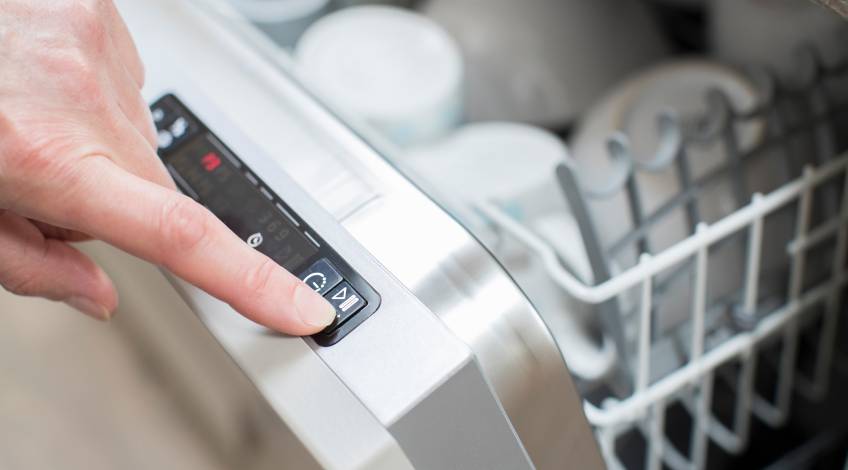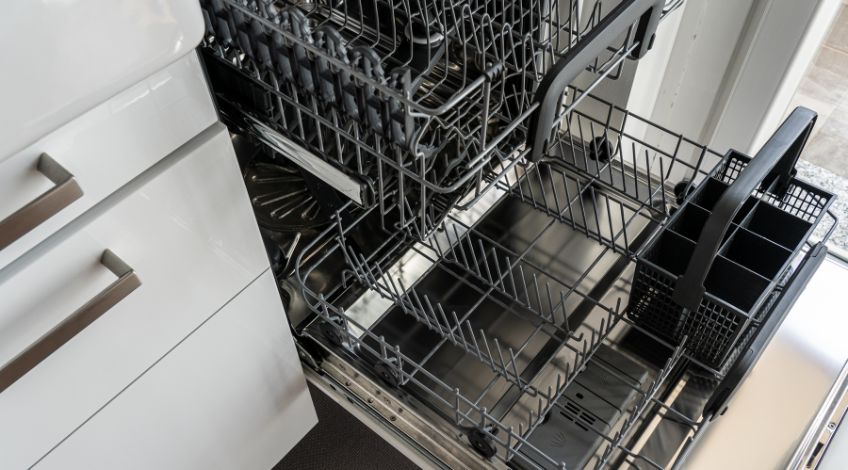
Dishwasher Not Draining? (here’s why & what to do)
One of the main problems we hear about dishwashers is standing water left in the bottom of the appliance after the cycle has finished. This is almost always caused by the dishwasher not draining properly.
This can be quite daunting but there’s no need to panic because in most cases this problem can be fixed without calling on an expert.
Why Is The Dishwasher Not Draining?
There are several problems that could prevent the dishwasher from draining which include;
| Probable Cause | Solution |
|---|---|
| Interrupted Cycle | Restart the cycle |
| Wrong Detergent Used | Always use good quality dishwasher detergent in the correct quantity |
| Clogged Filter | Clean the filter and remove any debris |
| Clogged Drain Hose | Inspect the drain hose and remove any blockages |
| Clogged Waste Disposal Unit | Inspect and remove any blockages from the waste disposal unit |
| Blocked Sink Drain | Clear any blockage |
| Blocked Air Gap | Inspect the air gap and remove any blockages |
| Defective Drain Pump | Replace the drain pump |
Removing Standing Water From The Dishwasher
Before we get started on investigating the probable causes of the dishwasher failing to drain, we need to remove any standing water from the tub.
This can be done in one of two ways which are;
- Using A Jug
Use a jug to scoop the standing water from the tub of the dishwasher and soak up any small puddles using a towel. - Using A Wet/Dry Vacuum
Once you have put the wet filter on the vacuum, turn it on and use the hose to suck all of the water away.
We have found that using a jug works best for small amounts of standing water. But the wet/dry vacuum works better if there is a substantial amount of standing water.
Wrong Detergent Used
One of the most common reasons for a dishwasher to fail to drain properly is because the wrong detergent was used. Dishwasher detergent is specially formulated to not produce too many soap suds.
Soap suds can cause the dishwasher to not drain properly. If you suspect that using an incorrect detergent has caused your dishwasher to fail to drain, run an empty cycle to clear any remaining soap suds.
Refrain from using any detergent that wasn’t specifically designed for use in a dishwasher in the future to prevent this from causing any more problems.
Interrupted Cycle

If the cycle was interrupted it could lead to standing water inside the dishwasher’s tub. This could be due to a power failure/outage or the cycle was interrupted accidentally.
Try restarting the cycle and see if that solves the issue.
Clogged Filter
The filter on a dishwasher is designed to trap any food particles or other debris washed from the dishes and prevent them from returning to the now clean dishes. Over time the filter can become clogged with food particles, grease, broken crockery pieces etc.
You will need to locate the filter which is typically found on the bottom of the tub under the lower rack. Remove the filter by twisting (most have directional arrows to indicate which way to turn) and then lifting it out.
You should then clean the filter under running water to remove all of the food particles and debris. If the filter is really dirty, you might need to soak it in warm water for around 20 to 30 minutes.
You could also scrub it using a toothbrush and if there are really stubborn clumps, soak the filter in a white vinegar and water solution (50/50 mix).
Check The Impeller
While you have the filter removed, look inside the housing, you will see the top of the drain pump. Inspect the pump’s impeller and remove any food particles, broken crockery etc that could be impeding the impeller.
Clogged Drain Hose

If the filter is not causing the problem, the next place to check is the drain hose. All of the waste water from the dishwasher runs through the drain hose which can become clogged at some point.
You can remove any blockages using a plumber’s snake once you have disconnected the drain hose from the appliance. You should also check the hose for any twists or kinks which will need to be straightened.
If you don’t feel confident enough to remove the drain hose, you could try adding 1 cup of bicarbonate of soda and 1 cup of white vinegar to the standing water in the base of the dishwasher. If you prefer, you could use a commercial dishwasher cleaner instead.
Allow this mixture at least 30 minutes (longer is better) to work on the blockage. After the allotted time has passed, check to see if the standing water has gone.
If it has, run a hot wash to ensure all of the gunk is washed away. If not you might have to resort to using a plumber’s snake.
Clogged Waste Disposal Unit
If your dishwasher is connected to your home’s waste disposal unit, you should check that there’s nothing clogging it. Try running the unit for around 30 seconds to clear any clogs.
If this doesn’t work consult your user manual, many disposal units can be manually operated using an allen key. All you do is locate the socket and insert the allen key. Then turn the key backwards and forwards until there is less resistance.
Blocked Sink Drain

If your dishwasher is connected to the drain under the kitchen sink, it’s possible that the sink has a blockage which is preventing the dishwasher from draining properly.
You will need to investigate the sink’s drainage system and look for any blockages.
Blocked Air Gap
In some cases, the drain hose is connected to an air gap to prevent dirty water from re-entering the dishwasher. Over time, the air gap can get clogged with grease, fat and food particles which can lead to the waste water not draining away from the dishwasher.
You will need to inspect the air gap and remove any blockage. To access the air gap, you will need to remove the cover and cap and inspect the tube for any blockages.
Anything you find can often be removed using a pair of tweezers. You should then run a tube brush as far into the tube as you can reach. If this is a step too far, we recommend getting a plumber to do this for you.
Defective Drain Pump
If you’ve eliminated everything else, the only place left to check is the drain pump itself. The drain pump can become clogged with food particles,grease or even bits of broken crockery.
Accessing the drain pump involves dismantling some of the panels on the dishwasher as well as removing the inlet hose. The pump will then need to be checked using a multimeter. Unless you are a capable DIY enthusiast, we recommend getting a technician to carry out this task.
What Can Be Done To Prevent The Dishwasher From Failing To Drain In The Future?
Even if the reason for your dishwasher failing to drain was because the filter was dirty, it’s better to prevent this from becoming a problem again. The best way to prevent this from happening again is to;
- Rinse All Dishes Before Placing Them in The Dishwasher
- Never Overload The Racks
- Always Use Good Quality Dishwasher detergent
- Always Place Detergent In The Correct Dispenser (don’t put it in the bottom of the tub)
- Clean The Filter At Least Once Per Month
- Run A Hot Service Wash At Least Once Per Month
SEE ALSO: How To Clean & Sanitise A Dishwasher (to remove smells & dirt)
Frequently Asked Questions
The most common reasons why the dishwasher won’t drain are; the filter is dirty or clogged, the drain hose is clogged, the use of an incorrect detergent, the waste disposal unit is blocked, the sink is blocked, the air gap is blocked or the drain pump is defective.
If there is standing water in the bottom of the dishwasher it is most likely due to the filter or drain hose being clogged. Or you have used the wrong type of detergent or the drain pump is defective.
You can clean the drain hose on your dishwasher by placing 1 cup of white vinegar and 1 cup of bicarbonate of soda in the bottom of the tub. Allow this mixture to work for at least 30 minutes which should be enough time for it to clear any blockage.
Also, follow us on Pinterest ...



